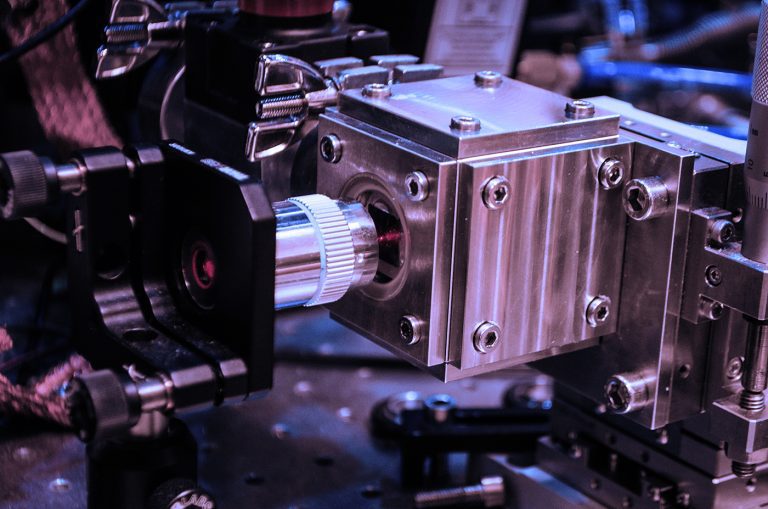Graphene-based pressure sensors allow further miniaturisation, leading to “the ultimate pressure sensor”, says PhD candidate Robin Joey Dolleman.
Under the supervision of Professors Peter Steeneken and Herre van der Zant, Dolleman is completing his doctoral degree at the Faculty of Applied Sciences with a thesis about the analysis of the mechanical properties of graphene membranes and their application for use specifically in pressure sensors. This thesis is part of the Integrated Graphene Pressure Sensors (IGPS) project proposed by the Netherlands Organisation for Scientific Research (NWO).
 The steel box contains a graphene membrane (Photo: Giulio Dacome)
The steel box contains a graphene membrane (Photo: Giulio Dacome)A very simple, yet very insightful, experimental set-up allowed Dolleman to gather a lot of information on the dynamic behaviour of graphene membranes. A system of lasers are pointed at a membrane in a small vacuum chamber. To take a photograph of it, Dolleman and a colleague turned the power of the beam up to the maximum, heeding the warning that they could not keep it up for long, otherwise they would risk ‘burning something’.
Among the various types of sensors studied during this project, the so-called Pirani sensor, developed in collaboration with the Else Kooi Laboratory, is extremely close to industrial application. This sensor exploits the fact that the thermal conductivity of graphene is pressure dependent: pressure allows graphene to dissipate heat better. Hence, by reading the resistance of the membrane which, in turn, is temperature dependent, one can work out the pressure.
Another interesting development in the thesis is the osmotic pressure sensor. Dolleman believes that this could also be used in the future for biomedical applications. The principle is simple. When two gaseous regions are separated by a membrane, and the concentration of a certain element is higher on one side than on the other, the membrane will feel pressure (the osmotic pressure) caused by this difference. This bends the membrane, hopefully graphene membrane, and its motion allows the sensor to reconstruct pressure and relative concentration.
Piece of the puzzle
But what about the future? Dolleman mentions that graphene, being a two-dimensional material, is still more expensive than current materials used. Industry still needs a lot more research before releasing a reliable product. Just like silicon in the early days. Eventually, Dolleman expects to “see something similar” as what happened with silicon, but maybe in 10 years. And for applications in electronic circuits … well, even longer. Nonetheless, his research constitutes a very important piece of the puzzle that will allow science to unveil the mysteries behind this thin layer of carbon atoms and, eventually, bring it to the public.
- R.J. Dolleman, Dynamics of interacting graphene membranes, PhD supervisors Professors Peter Steeneken and Herre van der Zant, 20 November 2018
Giulio Dacome / Stagiair



Comments are closed.